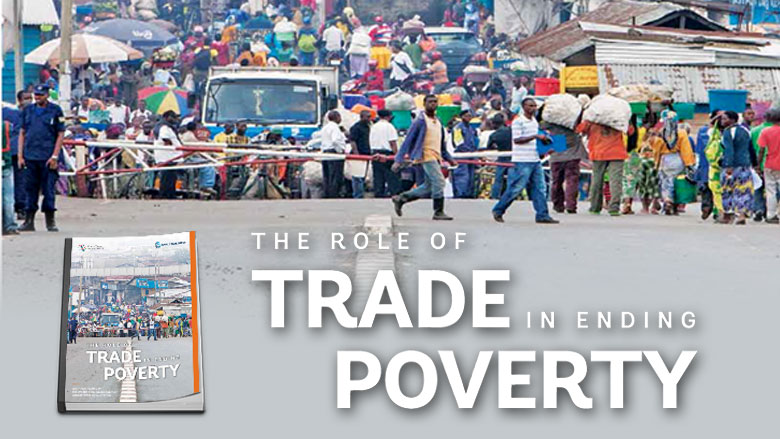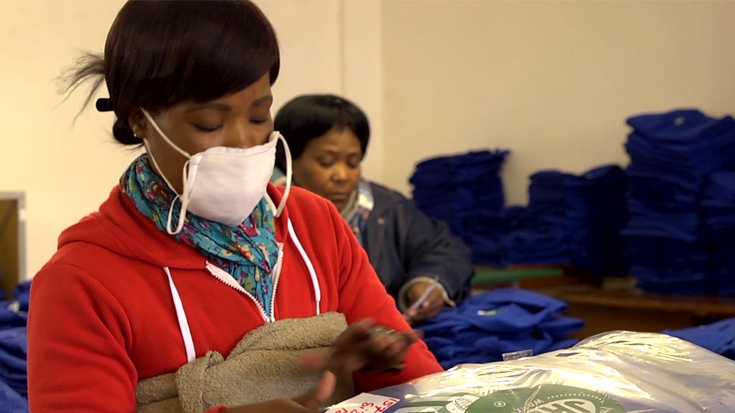Living under $1.25/day often involves running a single-employee businesses, many of them owned and operated by women or working for an informal sector firm, without a social safety net when economic shocks occur. In many countries, a significant proportion of trade involves people crossing borders on a daily basis to sell goods and services. And it is in these places – at dusty border crossings where produce sits idle unless and until bribes are passed, where pitted roads are inadequate to the traffic they carry, where poor farmers are disconnected from market opportunities, and where civil and interstate conflict slows commerce – that transformations in trade can benefit the world’s poorest and most vulnerable people.
Transformation might be as simple as a new road.
“Before we had the new road, selling our products and sending our kids to school was very difficult,” said one Laotian farmer. “Now cars from nearby villages can reach our village. And we can sell our goods.”
These are among the findings of a report published jointly today by the World Bank Group and the World Trade Organization. The report, “The Role of Trade in Ending Poverty,” was presented by World Bank Group President Jim Yong Kim and WTO Director General Roberto Azevêdo at the WTO’s Fifth Global Review of Aid for Trade.
A dramatic increase in developing country participation in trade has coincided with an equally sharp decline in extreme poverty worldwide. Developing countries now constitute 48 percent of world trade, up from 33 percent in 2000, and the number of people living in extreme poverty has been cut in half since 1990, to just under one billion people. Trade has helped increase the number and quality of jobs in developing countries, stimulated economic growth, and driven productivity increases,
But for the World Bank Group to achieve its Twin Goals of ending extreme poverty and boosting shared prosperity, the benefits of trade must be extended to the poorest and most vulnerable. This, in turn, requires a concerted effort by the international community working with the private sector and governments to establish and implement a comprehensive array of policies, programs, and financial interventions that will reduce the costs of trade and create a more transparent and predictable environment for regional and global commerce.
The extreme poor face numerous constraints that limit their capacity to benefit from wider economic gains. In this context, trade integration is important not only because of the boost to growth it can provide, but also because there is room for it be executed in ways that more effectively overcome the constraints faced by the extreme poor. A novel feature of this report is the link drawn between these challenges facing people living in extreme poverty and their capacity to benefit from trade, as a key driver of growth. The report describes four leading characteristics of the poor that have a particularly strong impact on their capacity to extract the full potential benefits of trade: rural poverty; fragility and conflict; informality; and gender.
Each of these four characteristics shapes the environment in which the extreme poor live, and constrains them from benefiting from trade opportunities. Poverty in many parts of the world — especially in Sub-Saharan Africa, where the challenge of ending extreme poverty is greatest — is a strikingly rural phenomenon. For the rural poor, trade and internal market barriers in agriculture present real challenges to benefiting from trade opportunities. More than half of the extreme poor live in fragile and conflict-affected areas (often dominated by revenues from high value minerals and other natural resources) and are less likely to be able to benefit from trade opportunities, even though export diversification by providing alternative livelihoods can be an essential pathway out of conflict. Poverty and informality often go hand in hand. Informal sector workers and the micro-enterprises that dominate the informal economy face particular challenges, and are vulnerable to sudden economic shocks. Finally, women are often at the forefront of poverty reduction, and trade has brought particular benefits for women in terms of jobs and empowerment. However, women face specific constraints, both within and outside the household, which can make it difficult to participate in and gain from trade opportunities.
The report outlines actions in five areas to address these constraints:
- Lowering trade costs for deeper integration of markets. Trade facilitation – including implementation of the WTO Trade Facilitation Agreement – as well as tackling other policy and infrastructure barriers to goods and services trade are critical to growth and poverty reduction.
- Improving the enabling environment. Trade openness itself and lowering trade costs is essential for delivering gains for the poor. A range of complementary policies helps maximize the gains of openness for the poor – including policies related to human and physical capital, access to finance, governance and institutions and macroeconomic stability. Strengthening the enabling environment can be done through innovative policy frameworks that improve consultation with the poor, and target their needs more carefully. To achieve this will require deeper cooperation across sectors, better coordination across government ministries and agencies and that a wider range of stakeholders work effectively together.
- Intensifying the poverty impact of integration policies. Bringing a greater focus on tackling remoteness from markets at the sub-national level, and facilitating the activities of poor and small traders, can help improve gains for the poor, especially in rural areas. This also entails reforms to tackle costs generated by a lack of competition, and other sources of domestic costs. Promoting greater inclusiveness of women, and targeting the challenges they face as distinct from men, is central to efforts to intensify the poverty impact of integration policies.
- Managing and mitigating risks faced by the poor. More focus is needed on managing the existing risks that poor people face that limit them from benefiting from trade opportunities when they arise. Effective risk management can be a powerful instrument for development, through building poor people’s resilience to the effects of adverse events and also by allowing them to take advantage of opportunities for improvement. Addressing any potential risks to livelihoods for the poor through trade-related adjustments is also important.
- Improving data and analysis to inform policy. The gaps in understanding of poverty, the nature of the informal economy, the participation of women in trade, and of the trade-related constraints in general that many countries face continue to be large. Better data is required for the design and implementation of effective policies to maximize the poverty reduction gains from trade.
Publication of the joint report is part of a broad effort by the Bank Group and WTO to support targeted policies designed to help integrate developing countries into the global economy.

